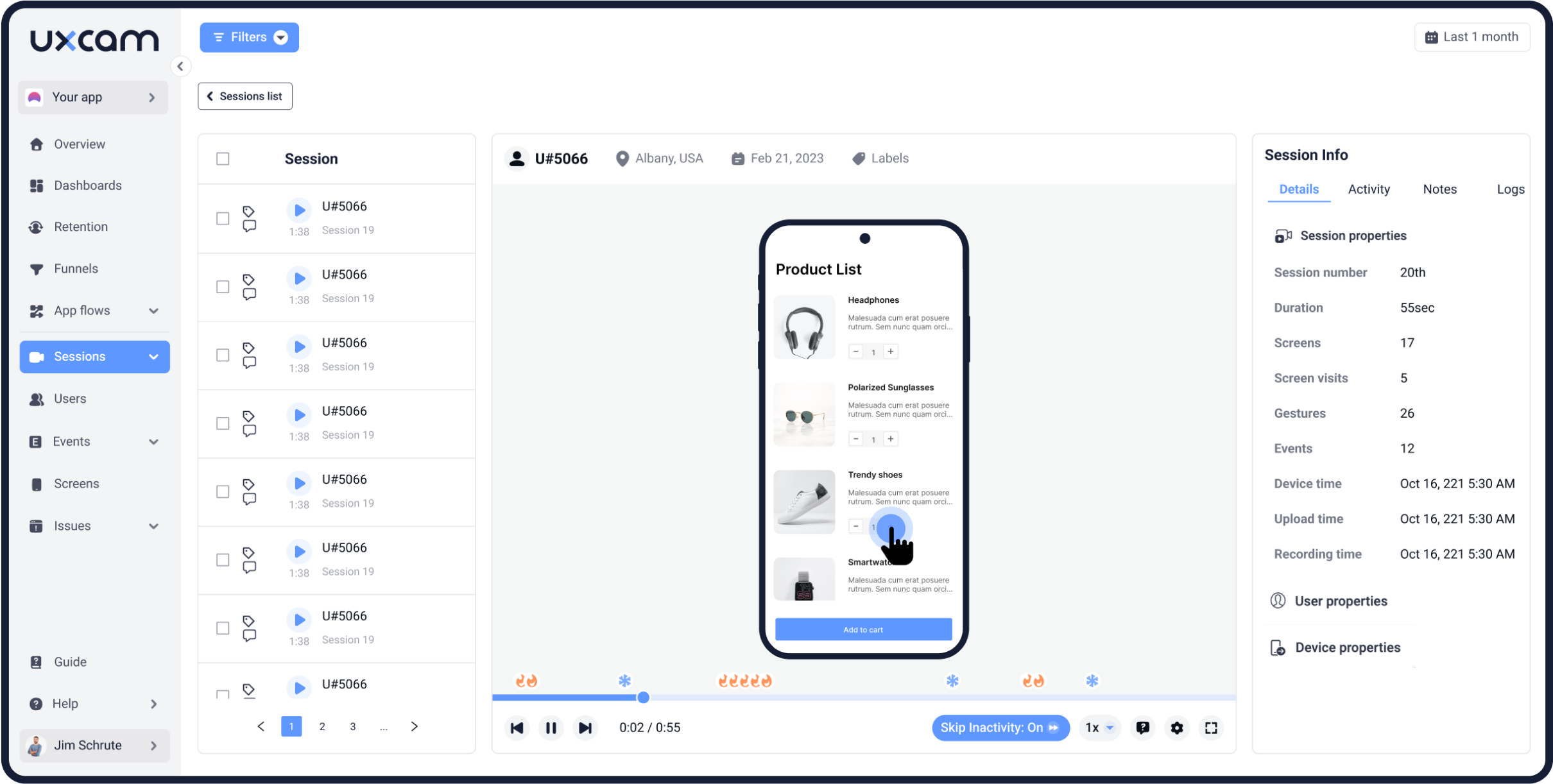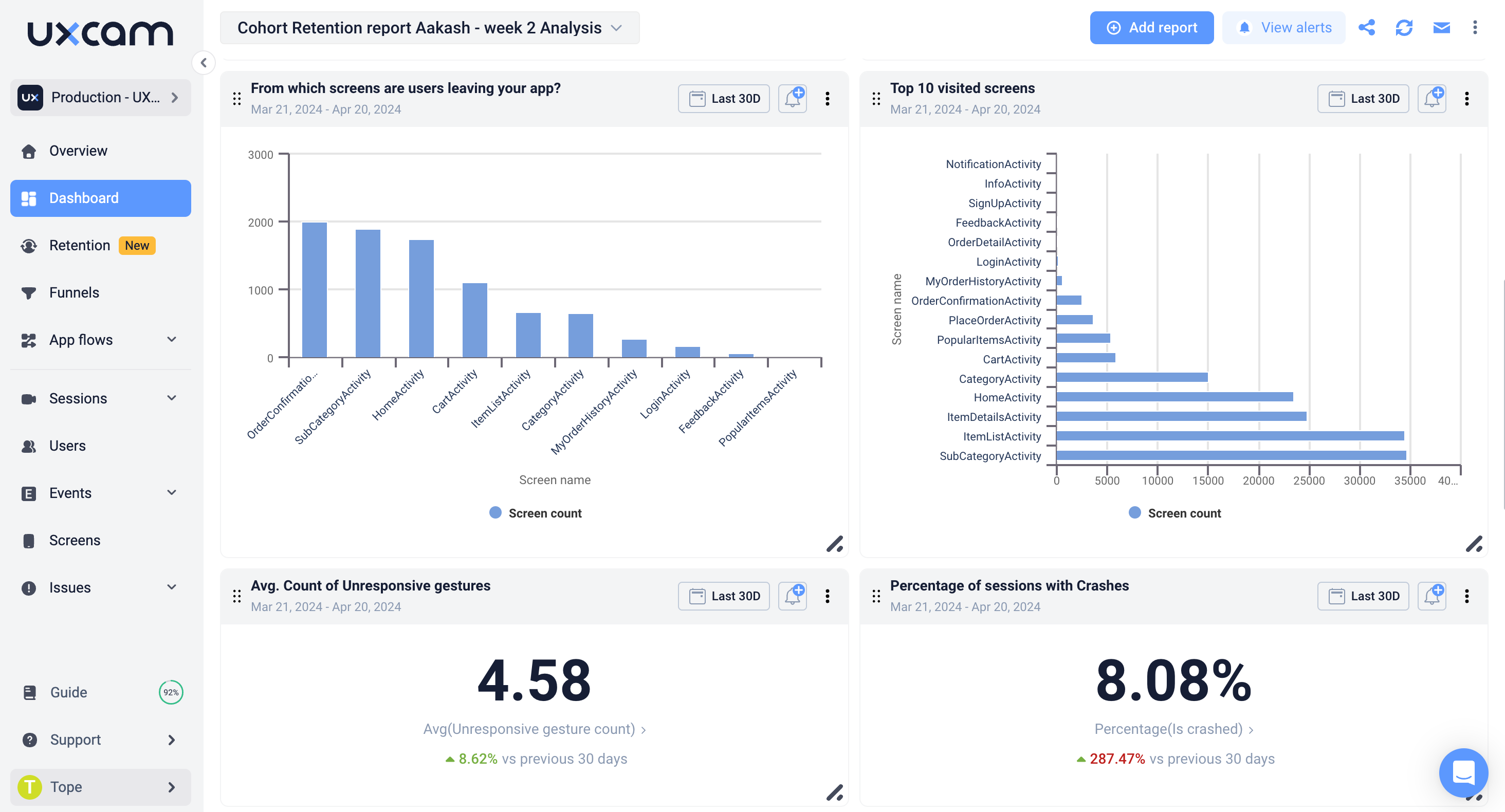Product Analytics Framework - Examples and How to use them
PUBLISHED
19 April, 2024

Growth Marketing Manager
Wondering how to set up a product analytics framework?
Using data intelligently is how you gain an advantage over your competitors. A good product analytics system helps companies make better choices based on facts, not just guesses.
According to McKinsey, companies that use customer data well are 23 times more likely to succeed than their competitors. This shows how important a solid analytics setup can be for growth.
At UXCam, we understand the importance of a product analytics framework in making smarter decisions. As such, we’ll guide you through how to set up a product analytics framework that puts you ahead in a competitive market.
Why listen to us?
When it comes to setting up a product analytics framework, our firsthand experience at UXCam speaks volumes. We've guided numerous businesses, big and small, to help them improve their product analytics.
Take the case of Housing.com, where the implementation of our platform’s session recordings and event analytics led to a 20% increase in feature adoption. Or consider Inspire Fitness, which saw user activity skyrocket by 460% thanks to a well-crafted product strategy based on UXCam's insights.
Without a doubt, companies that partner with us leverage our platform’s capabilities to the fullest, ensuring your product not only meets but exceeds user expectations.
Helpful summary
Overview: We highlight the significance of a product analytics framework in enhancing mobile app development. The right framework offers user experience insights, leading to informed decisions and superior market performance.
Why It Matters: Gathering insights into user experience is crucial for optimizing app performance and user satisfaction, with data-driven companies often outperforming their competitors.
Action Points: Implement a comprehensive analytics framework, utilizing tools like UXCam for real-time user behavior insights and optimizing based on these findings.
Further Research: Explore advanced analytics features like session recording, funnel analysis, and A/B testing to continuously refine your mobile app's user experience.
What is a product analytics framework?
A product analytics framework is a structured method for gathering, studying, and understanding data about how users interact with a product. It involves deciphering important user engagement metrics, setting up data collection, and using what you learn to make the product better.
Here are the main parts of a product analytics framework:
Setting Goals: Decide on product objectives aligning with business goals.
Choosing Metrics: Select key performance indicators to measure product success and user engagement.
Collecting Data: Implement tools to gather data from various sources such as usage logs, user feedback, and customer support interactions.
Putting Data Together: Consolidate all collected data into a unified platform for easier analysis and sharing.
Analyzing Data: Use mathematical models and visualizations to detect patterns and insights from the collected data.
Experimentation: Conduct experiments, A/B tests, and user surveys to optimize product performance and user satisfaction.
UXCam is a valuable tool for a mobile app that’s setting up its product analytics framework. Our platform offers real-time insights into user behavior and conversion rates, thereby highlighting what you need to improve.

For instance, Inspire Fitness used UXCam to refine its product strategy. By leveraging features like session recording, event analytics, issue analytics, and heatmaps, the team crafted a strategy centered around user needs. The outcome? A remarkable 460% increase in app usage time and an impressive 181% boost in new user sign-ups.
Examples of Product Analytics Frameworks
The AARRR Framework
Also known as Pirate Metrics, is a popular tool used by startups to track important metrics throughout a customer's journey:
Acquisition: How are users finding and accessing the product?
Activation: Are users having a positive initial experience with the product?
Retention: Do users keep coming back and using the product regularly?
Referral: Are users satisfied enough to recommend the product to others?
Revenue: How is the product generating income from the users?
The HEART Framework
Created by Google, this framework is useful for assessing the quality of the user experience and is made up of five key components:
Happiness: Measures how satisfied users are with the product.
Engagement: Tracks the level and frequency of user interactions with the product.
Adoption: Monitors the number of new users who are beginning to use the product.
Retention: Evaluates the product's ability to retain users over time.
Task success: Assesses the efficiency, effectiveness, and error rates involved in users completing tasks.
The Growth Accounting Framework
This is a helpful tool for analyzing user growth and is broken down into three categories:
New users: The total number of users who have used the product for the first time within a certain time frame.
Resurrected users: Users who have returned to using the product after a period of inactivity.
Churned users: Users who have stopped using the product altogether.
Benefits of using a product analytics framework
User behavior insights
Analytics helps product managers understand how users interact with their products, identify pain points, and optimize the user experience. A study by Forrester found that data-driven businesses are 58% more likely to beat revenue goals than non-data-driven companies.
Personalization
Analytics enables personalized user experiences based on user behavior and preferences. A survey by Epsilon found that 80% of consumers are more likely to make a purchase when brands offer personalized experiences.
Predictive Analytics
Advanced analytics can predict future user behavior and solve issues before they occur. A study by Deloitte discovered that companies focused on data-driven insights are twice as likely to surpass their business goals.
How to set up a product analytics framework
Define product goals and objectives
Identify key metrics and KPIs
Set up data collection
Implement user session recordings
Analyze user funnels
Conduct A/B testing
Analyze user feedback and sentiment
Create dashboards and reports
Continuously iterate and optimize
1. Define product goals and objectives
Success starts with clear goals that match your business strategy. Every decision should help you reach your business goals.
Once you've set your goals, focus on areas like user engagement, keeping users interested, and turning visitors into customers. Concentrating on these areas creates a better user experience, making users happier and more loyal.
To understand how your product is doing and find ways to make it better, use tools like UXCam. Features like Session Recording and Event Analytics let you see how users use your product. This helps you make smart decisions based on real user experiences.
One example is Housing.com, an Indian real estate website. They used UXCam to boost feature usage by 20%. Reviewing 50 to 100 user session recordings daily helped them pinpoint issues impacting the in-app user experience and investigate reasons for low adoption rates of specific app features.
2. Identify key metrics and KPIs
Determine the key metrics and KPIs that will help you measure the success of your product and track progress toward your goals.
UXCam provides a wide range of predefined metrics and allows you to create custom events and metrics specific to your product. Some of them are as follows:
Number of Active users (Daily, Weekly, and Monthly)
Most commonly used features among returning users
Screen exit rates
Drop-off percentage for the purchase process
Percentage of rage taps
3. Set up data collection
To establish effective data collection procedures, implement tools and processes that gather important information from diverse origins, including user interactions, application events, and user feedback. This ensures that the data collected is not only comprehensive but also reliable and accurate, meeting privacy regulations.
By integrating UXCam's SDK into the product, user sessions, gestures, and events can be automatically recorded without the necessity for manual tagging. This automated approach not only streamlines the data collection process but also enhances the depth and quality of the data acquired. It enables better insights into user behavior and interaction patterns within the application.
4. Implement user session recordings
Use session recordings to gain qualitative insights into user behavior and identify usability issues. Analyze user sessions to understand how users navigate your product, identify friction points, and uncover opportunities for improvement.
UXCam offers advanced session recording capabilities, allowing you to replay user sessions, view heatmaps, and filter sessions based on specific criteria.

5. Analyze user funnels
Create user funnels to visualize the user journey and identify drop-off points. Analyze conversion rates at each stage of the funnel and pinpoint areas for optimization.
UXCam's funnel analysis feature enables you to create and analyze user funnels, identify bottlenecks, and compare funnel performance across different user segments.
6. Conduct A/B testing
Use A/B testing to validate hypotheses and measure the impact of product changes on user behavior and key metrics. Test variations of user interface elements, features, or user flows to determine the most effective design.
UXCam integrates with A/B testing tools, allowing you to analyze the impact of different variations on user behavior and product metrics.
7. Analyze user feedback and sentiment
Don’t just look at what users do, ask them what they think. Collect and analyze user feedback from various channels, such as in-app surveys, app store reviews, and customer support interactions. You may also use sentiment analysis to gauge user satisfaction and identify common issues or feature requests.
UXCam integrates with tools like Survicate that have in-app survey capabilities, allowing you to gather user feedback directly within your product and analyze sentiment trends over time.
8. Create dashboards and reports
Build dashboards and reports to visualize key metrics, user behavior insights, and product performance trends. Share these dashboards with stakeholders to facilitate data-driven decision-making and collaboration.
UXCam offers customizable dashboards and reports, making it easy to visualize and share product analytics insights with your team.

9. Continuously iterate and optimize
Regularly review your product analytics data and insights to identify areas for improvement and optimization. Use the insights gained from session recordings, funnel analysis, A/B testing, and user feedback to inform product roadmap decisions and prioritize features.
UXCam's analytics platform provides ongoing insights and recommendations, helping you continuously iterate and optimize your product based on user behavior and feedback.
Conclusion
The right product analytics framework can be your app’s superpower. By leveraging data effectively, companies can make informed decisions, enhance user experiences, and drive growth.
At UXCam, we recognize the pivotal role of a product analytics framework in driving smarter business choices. After reading this guide, we hope you’re more educated on what goes into creating such a framework, from goal setting and metric selection to data collection, analysis, and continuous optimization.
By using tools like UXCam, you can gain deep insights into user behavior, optimize product performance, and stay ahead of the market. We empower you to make data-driven decisions that produce tangible results.
You might also be interested in these;
Product Analytics Examples - 5 Case Studies to Inspire You
12 Best Product Analytics Tools and Software 2024
How to Build a GDPR-Compliant Mobile App - Step-by-Step Guide
User Flow Analysis - A Step-by-Step Guide
5 Best Product Engagement Tools & Software 2024
AUTHOR

Tope Longe
Growth Marketing Manager
Ardent technophile exploring the world of mobile app product management at UXCam.
What’s UXCam?
Related articles
Session Replay
Mobile Session Recording - The Complete Guide 2025
Why session replay is such a valuable feature, and what you should look out for when starting...

Annemarie Bufe
Content Manager
Product Management
14 Best Product Development Software for Every Team 2025
Discover the 14 best product development software tools to streamline collaboration, track progress, collect feedback, and build better products...

Tope Longe
Growth Marketing Manager
Product Management
13 Best Product Management Tools 2025 & When to Use Them
Find out the top tools that the best product managers use daily to perform better at...

Jane Leung
Content Director
